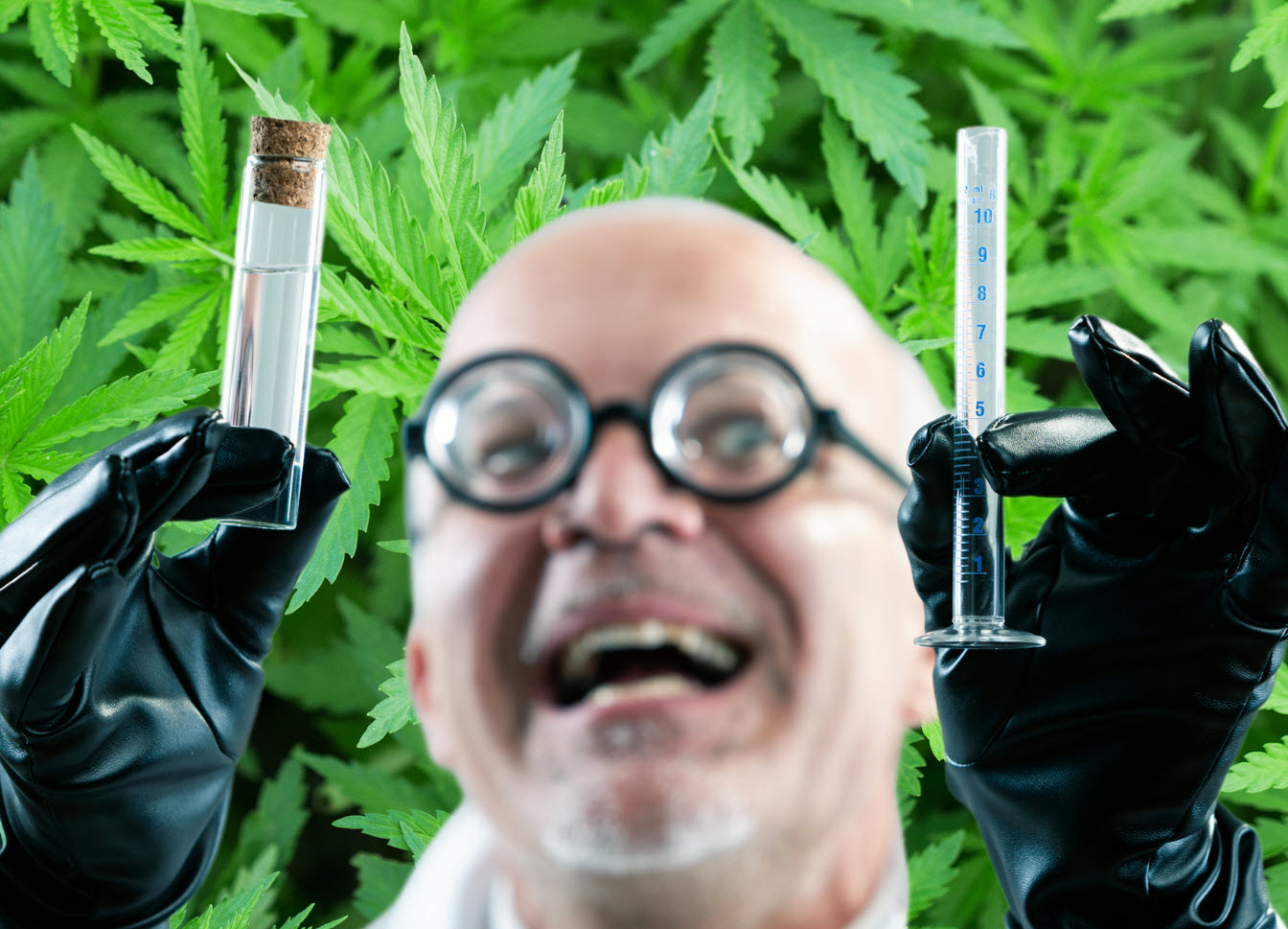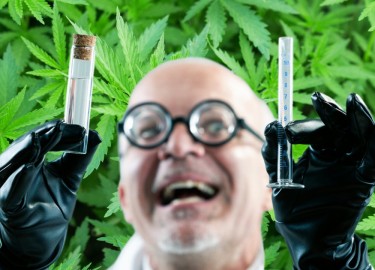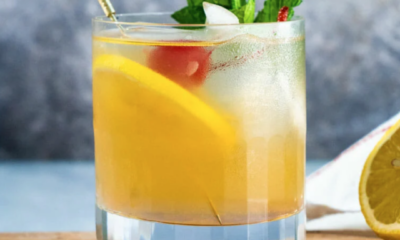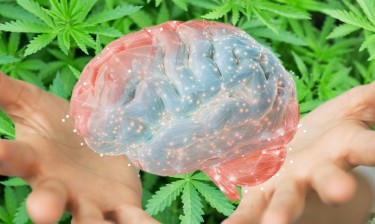Cannabis News
Cannabis Research Fraud? – Over Half of the $1.5 Billion Spent on Marijuana Research Was to Find Harmful and Adverse Effects
Published
12 months agoon
By
admin

A Tale of Two Studies
Exploring the nature of cannabis science
The pursuit of scientific truth is a noble endeavor, but it is not without its complexities and contradictions. Even as researchers strive for objectivity, the realities of funding, politics, and preconceived notions can influence the direction and interpretation of scientific inquiry. Nowhere is this more apparent than in the contentious field of cannabis research.
A 2020 analysis published in Science magazine revealed a striking disparity in cannabis research funding. Of the $1.56 billion directed to the topic between 2000 and 2018 in the United States, Canada, and the United Kingdom, roughly half was spent on investigating the potential harms and adverse effects of recreational cannabis use. The U.S. National Institute on Drug Abuse (NIDA), the largest funder, allocated more money to studying cannabis misuse and its negative consequences than to exploring the therapeutic potential of cannabis and its derived compounds.
This imbalance underscores a troubling reality: not all scientific research is created equal. Just as the tobacco industry once enlisted medical professionals to promote smoking, some cannabis research may be steered toward finding and emphasizing negative outcomes. Studies that dare to suggest therapeutic benefits or challenge prevailing narratives often face bureaucratic hurdles and skepticism from agencies like the Drug Enforcement Administration (DEA).
Against this backdrop, today we’ll examine two cannabis studies published just months apart. Though similar in design, these studies arrived at markedly different conclusions about the cognitive impacts of cannabis use. By juxtaposing their findings, we’ll shed light on the contradictory nature of cannabis research and the importance of critical thinking when interpreting scientific results.
As we delve into these studies, it’s crucial to remember that science is an ongoing process of discovery, not a collection of immutable truths. While some research may be tainted by agendas or biases, other studies earnestly seek to expand our understanding of this complex plant and its effects on the human body and mind. Only by approaching each study with a discerning eye and a willingness to question assumptions can we hope to navigate the murky waters of cannabis science and emerge with a clearer picture of the truth.
In the coming paragraphs, we’ll take a closer look at these two divergent studies, their methodologies, and their implications. By doing so, we aim to equip readers with the tools to critically evaluate cannabis research and make informed decisions in the face of conflicting scientific narratives.
The first study we’ll examine is titled “Regular cannabis use alters the neural dynamics serving complex motor control,” published in the journal NeuroImage in 2023. This study aimed to investigate the effects of regular cannabis use on the brain mechanisms underlying motor planning and execution. The researchers used magnetoencephalographic (MEG) imaging and time series analysis to compare the neural oscillatory dynamics of 18 regular cannabis users and 23 demographically matched nonuser controls during a motor sequencing task.
At first glance, the study appears to be well-designed and comprehensive. The researchers controlled for age, sex, race, and alcohol use, and participants underwent detailed interviews and screenings to assess their substance use patterns and overall health. MEG data were carefully processed and analyzed, and the results were presented with statistical rigor.
However, upon closer inspection, several inconsistencies and potential biases emerge. First and foremost, the study’s conclusion that regular cannabis use negatively impacts cognitive function seems to overreach the actual findings. While the researchers did observe differences in neural oscillatory patterns between cannabis users and nonusers, these differences did not translate into any significant impairments in task performance. In fact, the study explicitly states that “there were no group differences in task performance (e.g., reaction time, accuracy, etc.).”
This discrepancy raises questions about the researchers’ interpretation of their data. If cannabis users performed just as well as nonusers on the motor sequencing task, can we really conclude that their neural differences reflect a negative impact on cognitive function? It’s possible that the observed neural alterations represent compensatory mechanisms or adaptations that allow cannabis users to maintain normal performance despite chronic exposure to the drug.
Another potential issue lies in the study’s premise and framing. The researchers seem to approach the topic with the preconceived notion that cannabis use is inherently harmful, as evidenced by their emphasis on identifying “deficits” and “impairments” in the cannabis-using group. This bias may have influenced their interpretation of the neural data and led them to overstate the significance of the observed differences.
Furthermore, the study’s sample size of 41 participants (18 users and 23 nonusers) is relatively small, which limits the generalizability of the findings. The researchers also acknowledge that they could not control for the type, dose, or frequency of cannabis use among their participants, introducing additional variability that could confound the results.
Despite these limitations, the study’s authors assert that their findings “demonstrate that regular cannabis use is associated with alterations across multiple brain regions involved in motor control” and that these alterations “may be precursors of behavioral deficits that may emerge in the future.” While these statements are presented as definitive conclusions, they seem to rely more on speculation than on the actual evidence presented in the study.
Now, let’s take a look at another study on a similar subject matter and how they concluded…
The second study we’ll explore is titled “Medical cannabis does not impair cognitive function when used as prescribed,” published in the journal Drug Science, Policy and Law in 2022. This study took a different approach to investigating the cognitive effects of cannabis use, focusing specifically on patients using prescribed medical cannabis to manage various health conditions.
In this open-label trial, 40 participants (22 females) with a mean age of 41.38 years attended a single laboratory session where they self-administered their prescribed medical cannabis under supervision.
The researchers assessed cognitive performance using the Cambridge Neuropsychological Test Automated Battery (CANTAB) and Druid application (app) before and after cannabis administration. They also measured subjective drug effects using visual analog scales at multiple time points.
The study’s methodology has several strengths. By focusing on medical cannabis users following their prescribed regimens, the researchers captured a more realistic picture of how cannabis affects cognitive function in a clinical context. The use of validated cognitive assessment tools like CANTAB and Druid adds credibility to the findings, as does the inclusion of subjective measures to gauge participants’ experiences.
However, the study is not without limitations. The open-label design and lack of a placebo control group may introduce bias, as participants’ expectations could influence their performance and subjective ratings. The single-session format also provides only a snapshot of the acute effects of medical cannabis, leaving questions about long-term cognitive impacts unanswered.
Despite these caveats, the study’s results paint a strikingly different picture than the previous study on regular cannabis users. Participants’ performance on the CANTAB Multitasking Test and Rapid Visual Information Processing test actually improved over time, while all other cognitive measures showed no significant changes. These findings suggest that, when used as prescribed, medical cannabis may have minimal acute impact on cognitive function in patients with chronic health conditions.
The stark contrast between the conclusions of these two studies highlights the complex and often contradictory nature of cannabis research.
While the first study found neural alterations in regular cannabis users that were interpreted as potentially harmful, the second study found no evidence of cognitive impairment in medical cannabis patients following their prescribed regimens.
These divergent findings underscore the importance of context and nuance in interpreting scientific results. Factors such as the reason for cannabis use (recreational vs. medical), the specific products and doses consumed, and individual differences in health status and other variables can all influence the observed outcomes.
Moreover, these studies remind us that science is not a monolith but an ongoing process of inquiry and discovery. As new evidence emerges, our understanding of complex topics like cannabis and cognition evolves, sometimes in unexpected directions. While it’s natural to seek definitive answers and clear-cut conclusions, the reality is often messier and more ambiguous.
As consumers of scientific information, it’s crucial that we approach research findings with a critical eye, considering the strengths and limitations of each study and the broader context in which they exist. Only by embracing the inherent uncertainty and variability of scientific inquiry can we hope to make informed decisions and policies around contentious issues like cannabis use.
As we’ve seen through the examination of these two studies, the relationship between scientific research and public policy is far from straightforward. While science should ideally inform policy decisions, the reality is often more complex and politically charged.
The classification of cannabis as a Schedule I substance in the United States is a prime example of how scientific evidence can be overshadowed by historical, cultural, and political factors. Despite a growing body of research suggesting that cannabis has medical value and a lower potential for abuse than other Schedule I drugs, federal law continues to prohibit its use and severely restrict research efforts.
This disconnect between science and policy has far-reaching consequences. It perpetuates stigma and misinformation around cannabis use, hinders patients’ access to potentially beneficial treatments, and stifles scientific progress in understanding the plant’s complex effects on the human body and mind.
Moreover, it underscores the need for a more nuanced and evidence-based approach to drug policy. Rather than relying on simplistic categories and blanket prohibitions, policymakers should engage with the scientific community to develop regulations that prioritize public health, harm reduction, and social justice.
However, as the contrasting findings of the two studies we examined demonstrate, scientific evidence is rarely unequivocal or immune to bias. Researchers’ assumptions, methods, and interpretations can all shape the narrative around a particular topic, leading to conflicting conclusions and public confusion.
This is why it’s crucial for both policymakers and the general public to approach scientific findings with a critical eye. Rather than taking sensationalized headlines or cherry-picked results at face value, we must dig deeper into the methodology, sample sizes, limitations, and potential conflicts of interest behind each study.
We must also recognize that science is an iterative process, and that our understanding of complex issues like cannabis and cognition will continue to evolve as new evidence emerges. This means embracing uncertainty and nuance, rather than clinging to simplistic narratives or entrenched positions.
Ultimately, the sticky bottom line is that science and public policy are inextricably linked, but the relationship between them is often messy and contentious. As responsible consumers of scientific information and engaged citizens, we have a duty to approach research findings with a critical eye, to demand evidence-based policies from our leaders, and to advocate for a more transparent and accountable scientific enterprise.
Only by fostering a culture of informed skepticism and open-minded inquiry can we hope to untangle the complex web of science, politics, and public opinion surrounding issues like cannabis use. It’s a daunting task, but one that is essential for creating a more just, healthy, and evidence-based society.
THE CANNABIS COGNITIVE FUNCTION STUDY, READ ON…
CANNABIS SLOW COGNITIVE DECLINE AND DEMENTIA, READ THIS STUDY!
You may like
-


Karma Koala Podcast 247: Speaking with Dr. Natalie Corthésy senior lecturer university of West Indies & Enrico Bonadio professor of law City St George’s University of London about their forthcoming Edward Elgar title, “Intellectual Property and Cannabis”
-


MJBizCon offers speakers chance to share cannabis insights, shape industry
-


The Best Tariff Friendly Cocktails
-


Cannabis Consumers Are Being Hit By The Tariffs
-


The Best Tips To Update Your Wardrobe
-


Former New York Knick Iman Shumpert debuts ‘TSA Approved’ legal cannabis brand
Cannabis News
Scientists Now Think That One Compound in the Cannabis Plant Can Replace All Opiates
Published
1 day agoon
April 3, 2025By
admin

Which Cannabis Compound Do Scientists Think Can Replace Opiates?
…And Why This Is Important
Opiates are a type of pharmaceutical drug that’s been made from the opium poppy plant. While it’s somewhat a ‘natural’ substance that’s been extracted from the fibers and sap of the opium poppy plant, these are extremely dangerous sedatives that act on the central nervous system. However, there are completely synthetic opioids as well, which are manufactured entirely in laboratories.
Famous examples of well-known and widely-used opiates today include heroin, codeine, and morphine. They all work similarly, binding to the brain’s opioid receptors and users feel a drastic reduction in pain. It also causes users to feel euphoric, drowsy, or sleepy. Common side effects include constipation and nausea.
Because opiates are powerful for dulling one’s pain perceptions, they have become commonly prescribed by doctors and hospitals for pain relief. That said, opiates have become one of the world’s most addictive, dangerous, and fatal drugs – and you can get prescribed it right by your very own physician. Repeated use of opiates can easily lead to dependence and addiction, and eventually consuming high doses can drastically slow down breathing, and cause brain damage, or even death.
Since doctors still keep prescribing opioids, this has resulted in the deadly Opioid Epidemic, which has killed thousands of people. It’s a worrisome public health crisis, most especially because of fentanyl, an illegally manufactured opioid which is said to be 50 times more potent than heroin.
Could The Answer To The Opioid Epidemic Lie In Cannabis…Terpenes?
The past few years have shown that cannabis legalization is critical for surviving the opioid epidemic, and reducing overall opioid consumption.
The results of a recent research paper, which builds on past studies conducted by Dr. John Streicher, who is a member of the Comprehensive Center for Pain and Addiction, reveals fascinating findings. According to Streicher, cannabis terpenes were found to provide relief in inflammation models as well as on neuropathic pain caused by chemotherapy.
For the study, Streicher and his research team analyzed 4 kinds of terpenes that are found in mid to high levels in Cannabis sativa plants: linalool, geraniol, beta-caryophyllene, and alpha-humulene. They discovered that each terpene produced significant pain relief among mice subjects with fibromyalgia and post-operative pain, and among the terpenes, geraniol was found to be the most powerful.
“Our research is showing that terpenes are not a good option for reducing acute pain resulting from an injury, such as stubbing your toe or touching a hot stove; however, we are seeing significant reductions in pain when terpenes are used for chronic or pathological pain,” he said. “This study was the first to investigate the impact of terpenes in preclinical models of fibromyalgia and post-operative pain and expand the scope of potential pain-relieving treatments using terpenes,” Streicher said.
Cannabis terpenes are the compounds responsible for the aromatic profile of each strain; they are located in the plant trichomes. Not only do they contribute to each strain’s unique flavor and odor, but they also have valuable therapeutic and medicinal benefits. There are around 150 kinds of terpenes known today, though in the entire plant world, there are known to be some 20,000 terpenes.
Understanding the therapeutic benefits of terpenes is incredibly valuable also because they don’t contain THC (tetrahydrocannabinol), the compound in marijuana that gets you high.
“With fibromyalgia, there isn’t much of an understanding of what the pain state is, and there are not a lot of great options for treating it,” explains Streicher. “Our findings show that terpenes may be a viable treatment option for fibromyalgia pain, which could potentially have a large impact and make a difference for an under-treated population.”
Other Studies
This is not the first time that cannabis terpenes have been found to demonstrate excellent pain-relieving properties. It must be noted that just like what Streicher says, terpenes seem to do better with chronic pain management, instead of acute pain management.
Another study from 2024, which was published in The Journal of the Association for the Study of Pain, was conducted by researchers at the University of Arizona and the National Institutes of Health. The investigators analyzed the analgesic properties of different terpenes including geraniol, humulene, linalool, pinene, and caryophyllene among mice subjects with chemotherapy-induced peripheral neuropathy.
According to the researchers, all the terpenes delivered analgesic effects that were equivalent to around 10 mg/kg of morphine. It was also interesting to note that administering both morphine and terpenes together at low doses resulted in ‘enhanced’ pain-killing effects.
“Together these studies identify cannabis terpenes as potential therapeutics for chronic neuropathic pain,” said the investigators.
There have also been other studies that have found that combining cannabis with opioids can indeed provide long-lasting pain relief. It comes with the added benefit of reducing opioid doses needed for effective pain control. This phenomenon is called opioid-sparing. These types of protocols can be beneficial for patients who suffer from severe, chronic pain caused by cancer, arthritis, joint problems, fibromyalgia, diabetes, post-surgical pain, migraines, nerve damage, and so much more.
Conclusion
Learning more about the pain-killing properties of terpenes is extremely valuable for the medical community, patients, and even society as a whole. We can all do with less opioid addictions because it has torn families apart, and caused the deaths of thousands of people.
Terpenes, or cannabis in general, offer a natural and safe alternative that can be complementary to other pharmaceutical treatments designed to reduce pain.
SWAPPNG OPIOIDS FOR CANNABIS, READ ON…


Cannabis and the Authoritarian State
Cannabis has been legal for longer than it has been illegal. Let that sink in for a minute. For thousands of years, humans cultivated and consumed cannabis freely across civilizations and continents. It wasn’t until the early 1900s that we witnessed a massive push to drive hemp and cannabis into the black market, primarily due to industrial competition from petrochemicals, pharmaceuticals, and other industrial applications.
What makes cannabis so threatening to powerful interests? For starters, hemp and cannabis are highly versatile crops with over 50,000 different uses, from medicine to textiles to fuel. Even more remarkable is how this plant is hardwired to work with the human body through our endocannabinoid system—a biological network we didn’t even discover until the 1990s.
Perhaps most threatening of all is that cannabis is insanely easy to grow. This means that if the plant helps you with a particular physical ailment, you have the ability to grow your own medicine indefinitely. No insurance premiums, no wait lists, no pharmaceutical middlemen—just you cultivating your own healing directly from the earth.
Authoritarians do not like this, not one bit. When people can meet their own needs independently, power structures lose their grip. When citizens can think differently without permission, control systems begin to fail. So today, we’re going to look at the interesting relationship between authoritarianism and cannabis, and how this humble plant plays a key role in keeping you free.
We’ve already established the versatility of cannabis, but there’s another element that those old D.A.R.E. PSAs inadvertently reveal about what authoritarians think about cannabis. I’m talking, of course, about “behavior.” You see, in an authoritarian system, you and I are but cogs in the machine. We’re the expendables who should be proud to work ourselves to death for our “fearless leaders.”
This is precisely why certain ideas, philosophies, religions, movements, books, and substances are typically banned in authoritarian regimes. Take North Korea as an example: everything from the type of television citizens watch to the music they hear is a tightly spun spell designed to keep the populace in check. While they don’t have explicit laws against hemp (they actually grow it industrially), smoking psychoactive cannabis is strictly forbidden.
Contrast this with places like Malaysia, where you can get up to 5 years for possessing just 20 grams of cannabis, and even face the death penalty depending on the situation. These authoritarians don’t play around when it comes to cannabis because they know it affects the behavior of their populace in ways they can’t control.
The question becomes: what behavior do they fear so much that cannabis produces within the individual?
The answer is a critical mind. People who consume cannabis often begin to question their own belief systems. Most regular users undergo some transformation in their values and perspectives. Cannabis has a unique way of helping people see beyond cultural programming and think outside established paradigms. It can make the familiar strange and the strange familiar—a psychological state that’s antithetical to authoritarian control.
This independent thinking runs counter to the narrative of authoritarians who wish to maintain a tight grip on social consciousness. If even 10% of a population begins to pivot in their behavior within a regime, it can have massive ripple effects. Just look at cannabis in the US—it went from being demonized to being embraced by the majority in less than 80 years, despite massive propaganda efforts.
For authoritarians, psychoactive cannabis isn’t primarily a threat to public health and wellbeing—it’s a threat to the health and wellbeing of authoritarianism itself. When people start thinking differently, they start living differently. When they start living differently, they start demanding different. And that’s the beginning of the end for any system built on unquestioning obedience.
Beyond the threat to thought control, there’s another reason why drugs in general remain illegal: the state can use prohibition as a weapon against the populace. This isn’t conspiracy theory—it’s documented history.
Take Nixon’s war on drugs. His domestic policy chief, John Ehrlichman, later admitted: “We knew we couldn’t make it illegal to be either against the war or black, but by getting the public to associate the hippies with marijuana and blacks with heroin, and then criminalizing both heavily, we could disrupt those communities.” Nixon essentially placed cannabis on the Controlled Substances Act because he needed an excuse to shut down anti-war protests and target Black communities.
Since hippies and anti-war protesters were smoking “freedom grass,” making it illegal would circumvent their freedom of speech and freedom of assembly, and more importantly—turn free citizens into state property. It’s a win-win if you’re an authoritarian looking to silence dissent.
Then there’s the whole “boogeyman” complex that prohibition creates. We’re told “drug dealers” are roaming the streets preying on innocents, giving them “marihuanas” so they can do vile things. What the government conveniently leaves out is how the banks these “dealers” use to launder their money remain untouched. They don’t mention the shadier dealings of law enforcement either—like running guns into Mexico (eventually leading to the death of one of their own), or spraying poison on crops, killing and hospitalizing people because, you know…”Drugs are bad!”
Authoritarians cannot let go of the value that keeping the most widely used illicit substance in the world illegal provides them. This explains why the US hasn’t federally legalized cannabis despite nearly 80% of Americans supporting some form of legalization. It’s not because they don’t have enough research or that they’re genuinely concerned about public health—it’s because prohibition gives them all the privileges of violating constitutional rights while siphoning money into their coffers.
Drug prohibition creates a perpetual enemy that can never be defeated, allowing endless justification for surveillance, militarized police, asset forfeiture, and expansion of state power. What authoritarian could resist such a convenient tool?
Cannabis is a plant. You can’t make nature illegal—it’s counter to the human experience. When governments attempt to criminalize a naturally occurring organism that humans have cultivated and used for thousands of years, they reveal the absurdity of their position and the limits of their authority.
While the United States isn’t a full-on authoritarian state (yet), the truth is that many authoritarian elements have played out over the years. You only need to look as far as the war on drugs to see how the state utilizes prohibition as a weapon to their advantage. From no-knock raids to civil asset forfeiture to mass incarceration, drug laws have erected a parallel legal system where constitutional protections often don’t apply.
The fundamental truth is that cannabis is not only versatile and medicinal, it gives you back your autonomy in multiple ways. It helps you think for yourself. It allows you to grow your own medicine. It connects you with a plant that humans have used ceremonially, medicinally, and industrially throughout our history. And this autonomy is something authoritarians cannot stand—free individuals who know how to think beyond the narratives they’re fed.
Cannabis doesn’t just get you high—it offers a perspective from which the absurdities of prohibition become glaringly obvious. Perhaps this is why, as state after state legalizes, we’re witnessing the slow but steady unraveling of one of the most enduring authoritarian policies in American history.
So if you count yourself among those who value freedom of thought and bodily autonomy, who believe that nature doesn’t require government permission, and who understand that true liberty includes the right to explore your own consciousness—well, maybe it’s time to toke one up for freedom!
LEGALIZING CANNABIS IS NOT ENOUGH, READ ON..
Cannabis News
Stop Using Bat Poop to Fertilize Your Weed Plants Immediately, Here is Why…
Published
3 days agoon
April 1, 2025By
admin

Don’t Fertilize Your Weed with Bat Poop
Fertilization is a critical step for growing healthy marijuana plants.
They help provide essential nutrients for marijuana in various stages of growth, while promoting plant growth. There are dozens of different fertilizers to choose from in the market; growers can choose based on budget, nutrients needed, location, season, and much more. But not all fertilizers are made equally – of course, some are of better quality than others.
That said, there are some rather unusual fertilizers that can be used on plants. These may include, but are not limited to: coffee, milk, grass clippings, banana peels, fish tank water, potato water, and even urine! Yes, it does sound strange, but to gardening enthusiasts, there is nutritional value to be found in each of these things, which can make them suitable fertilizers depending on the circumstances.
For example, grass clippings make excellent mulch and can provide potassium, nitrogen, and phosphorus. Urine is a potent source of nitrogen as well as phosphorus. Banana peels are rich in calcium, which is excellent for promoting root growth while helping supply oxygen to the soil.
But what about bat poop? Also known as guano, bat poop has been said to work as a plant fertilizer because it’s rich in nitrogen, potassium, phosphorus, and other nutrients. Unfortunately, using bat poop as a plant fertilizer can also be dangerous. So if you don’t really know what you are doing, bat poop as a fertilizer can be extremely risky.
Bat Poop Fertilizer Kills 2 NY Men
On December 2024, news of two men hailing from Rochester, New York, dying went viral.
The cause of death was dangerous fungus, in the bat poop that they were using to fertilize their marijuana plants. Both men grew their own marijuana plants for medical consumption, but unfortunately developed histoplasmosis after breathing toxic fungal spores from the guano.
One of the men was aged 59 years old; he bought bat poop online to use as fertilizer for his plants. Meanwhile, the other was a 64-year-old male who found guano in his attic, then decided to use it to fertilize his cannabis plants. They both developed similar symptoms, including chronic coughs, fever, severe weight loss, and respiratory failure. The case was also discussed in the Open Forum Infectious Diseases medical journal.
Is there a safe way to use bat poop as fertilizer? If you ask me, I truly can’t understand why one would use guano as fertilizer when there are so many other proven safe alternatives out there that are simply not as risky. According to the University of Washington, one must always wear a dust mask each time you open a bag containing soil amendments. That’s because a mask will greatly decrease the chances of breathing in fungal spores, which could be potentially dangerous. They also go on to explain that yes, guano is indeed used as fertilizer for its valuable nitrogen content but it still isn’t without its own risks, particularly of developing Histoplasma – the same condition that killed the two men.
Make Your Own Safe Fertilizers At Home
There are many other safe, affordable – and even free – fertilizers you can feed your marijuana plants with. It doesn’t have to cost a fortune nor does it have to be risky to your health.
Check out these easy, low-cost, DIY fertilizers for weed:
-
Coffee grounds are abundant in nitrogen, which makes it perfect for the vegetative stage of marijuana plants. They are also a fantastic source of organic materials and green waste, which contain other vital nutrients. When the coffee grounds decompose, they create soil aggregates that improve soil aeration and its water retention capabilities.
Mix around 2 grams of coffee ground for every liter of soil. Measuring its pH levels is also helpful, since you want it to be between 6 to 6.5
-
Crushed eggshells are a great way to ensure no eggshells go to waste. It’s rich in calcium plus other minerals that are effective in improving overall plant structure, health, and growth. In fact, so many gardeners and farmers commonly use crushed eggshells to help boost plant growth – and it will work just as well for marijuana plants.
They’re really easy to use, too! Just mix eggshells into the soil, or steep them into water then pour into the soil for a calcium-packed feed.
-
Banana tea or water is rich in potassium and magnesium, making it perfect as a feed during the marijuana plant’s flowering stage. You can use banana peels differently: with 3 to 5 banana peels, soak it in water for 2 days. Then you can use the water on your plants, and even leave the banana peels as compost for your garden.
-
Wood ash from your fireplace or other sources is a great source of phosphorus and potassium. Simply sprinkle some wood ash over marijuana during the final flower phase. Just use 1 or 2 grams of ash for every liter of substrate. Be careful not to use too much wood ash, or it can make the soil too alkaline.
-
Animal manure, such as those from cows, rabbits, or horses, make excellent organic fertilizers. Just be sure that they’re composed properly so that you avoid introducing weed seeds, or pathogens.
These low-cost fertilizers are also natural and effective. There’s no reason for you to turn to bat poop as fertilizer, even if you’re in a bind.
Conclusion
Guano or bat poop is a poor choice of fertilizer if you don’t know what you are doing. It’s risky and potentially dangerous – just not worth it. Instead, fertilize your marijuana plants with these options mentioned.
BEST POOP FOR CANNABIS PLANTS, KEEP READING…

Karma Koala Podcast 247: Speaking with Dr. Natalie Corthésy senior lecturer university of West Indies & Enrico Bonadio professor of law City St George’s University of London about their forthcoming Edward Elgar title, “Intellectual Property and Cannabis”

MJBizCon offers speakers chance to share cannabis insights, shape industry

The Best Tariff Friendly Cocktails

Cannabis Consumers Are Being Hit By The Tariffs

The Best Tips To Update Your Wardrobe

Former New York Knick Iman Shumpert debuts ‘TSA Approved’ legal cannabis brand

How New York pot pioneers made it to legal dispensary shelves

Scientists Now Think That One Compound in the Cannabis Plant Can Replace All Opiates

Vladimir Bautista is leading Happy Munkey’s legacy-to-legal takeover

Cannabis Can Help A Sore Throat

Distressed Cannabis Business Takeaways – Canna Law Blog™

United States: Alex Malyshev And Melinda Fellner Discuss The Intersection Of Tax And Cannabis In New Video Series – Part VI: Licensing (Video)

What you Need to Know

Drug Testing for Marijuana – The Joint Blog

NCIA Write About Their Equity Scholarship Program

It has been a wild news week – here’s how CBD and weed can help you relax

Cannabis, alcohol firm SNDL loses CA$372.4 million in 2022

A new April 20 cannabis contest includes a $40,000 purse

Your Go-To Source for Cannabis Logos and Designs

UArizona launches online cannabis compliance online course
Trending
-

 Cannabis News2 years ago
Cannabis News2 years agoDistressed Cannabis Business Takeaways – Canna Law Blog™
-

 One-Hit Wonders2 years ago
One-Hit Wonders2 years agoUnited States: Alex Malyshev And Melinda Fellner Discuss The Intersection Of Tax And Cannabis In New Video Series – Part VI: Licensing (Video)
-

 Cannabis 1012 years ago
Cannabis 1012 years agoWhat you Need to Know
-

 drug testing1 year ago
drug testing1 year agoDrug Testing for Marijuana – The Joint Blog
-

 Education2 years ago
Education2 years agoNCIA Write About Their Equity Scholarship Program
-

 Cannabis2 years ago
Cannabis2 years agoIt has been a wild news week – here’s how CBD and weed can help you relax
-

 Marijuana Business Daily2 years ago
Marijuana Business Daily2 years agoCannabis, alcohol firm SNDL loses CA$372.4 million in 2022
-

 California2 years ago
California2 years agoA new April 20 cannabis contest includes a $40,000 purse







